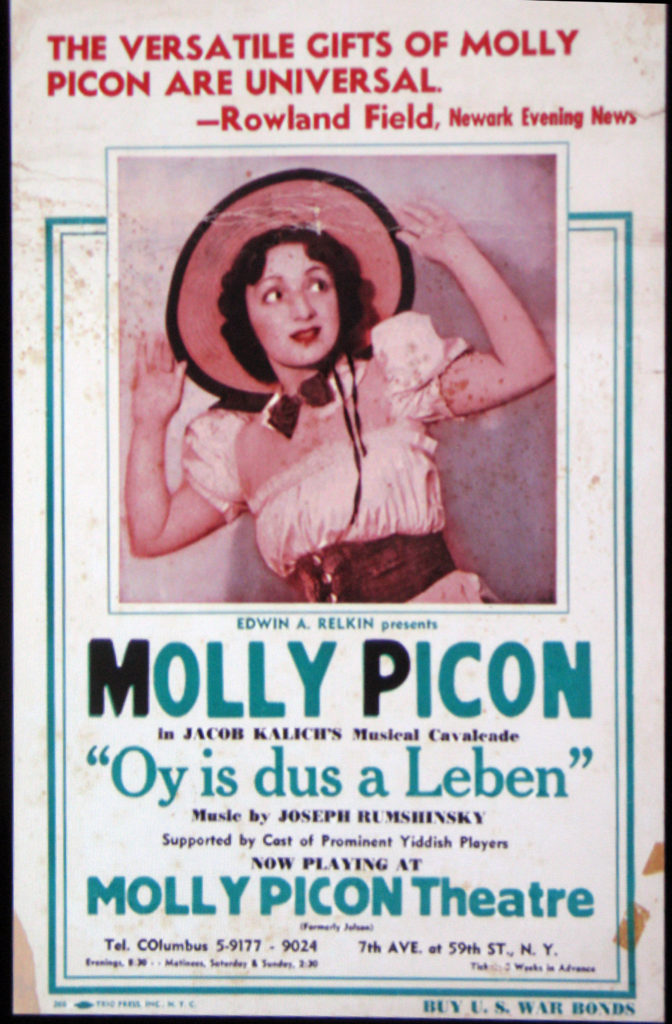The National Yiddish Theatre Folksbiene of New York is preparing to mount a revival this summer of an old Yiddish musical comedy, Di Goldene Kale (The Golden Bride), to be performed in Yiddish with English subtitles.
The story concerns a woman in a Russian shtetl who inherits a fortune, immigrates to America and offers marriage to any suitor who can find her mother. The New Yorker called it “a touching time capsule of the hopes and fantasies of Jewish immigrants circa 1923.” (The production runs July 4 to Aug. 28 at the Museum of Jewish Heritage.)
READ: HOW A RARE SUPERMAN SKETCH ARRIVED AT THE ONTARIO JEWISH ARCHIVES
Some folks from the Folksbiene held a preview evening to promote Di Goldene Kale in early May at the Museum of the City of New York. For me, the evening helped to set the tone for a recent five-day, largely sightseeing visit to New York, during which I also enjoyed the Jewish Museum, the Lower East Side Tenement Museum, the Center for Jewish History, and the Broadway Theatre where an invigorating new production of Fiddler On The Roof has been thrilling theatregoers.
Located at 1220 Fifth Avenue at 103rd Street, the Museum of the City of New York houses a diverse collection in a magnificent, early-1930s Georgian-Colonial Revival mansion. Currently on exhibit is the show Yiddish Theater: From the Bowery to Broadway, which encapsulates the rich history of New York’s Yiddish theatre, which blossomed on the Lower East Side from the late 19th century to the mid-20th century.

Maurice Schwartz, Molly Picon, Ludwig Satz, Jacob Gordin, Sophie Tucker, Menasha Skulnik, Al Jolson, Fanny Brice and so many others (even Barbra Streisand) are represented in posters, production stills, costumes, cartoons and other artifacts. This major exhibition is well worth seeing and remains on view until July 31.
Down the street at 1109 Fifth Avenue (at 92nd Street), the Jewish Museum is currently exhibiting Roberto Burle Marx: Brazilian Modernist, a show about an innovative 20th-century landscape architect. Rarely does a museum focus on the work of a landscape architect, but this one merits it: some of his public projects are considered icons in Brazil. The Jewish Museum’s permanent exhibits, of course, provide excellent background for those interested in the themes of Jewish culture, history, roots and immigration.
The Lower East Side Tenement Museum, at 97 Orchard St. (below Delancey), remains one of my favourite destinations in New York, but I hadn’t been back since shortly after it opened in the 1990s. Dating from 1863, this stunning example of a pre-code, “old-law” tenement building now offers a multitude of daily walking and building tours, departing on the hour, half-hour, even quarter-hour, a testament to the huge numbers of visitors the museum now receives. Exploring 97 Orchard Street, Irish Outsiders, Hard Times, Sweatshop Workers and Tastings at the Tenement are only some of the diverse range of tours on offer.
As a result of modernized municipal codes that demanded indoor toilets, airshafts and the like, the building was closed off above the ground floor in the 1920s and remained abandoned until 1988. Some apartments have been painstakingly restored, while others, for comparison’s sake, have been left in dilapidated condition. Tour guides bring the stories of the immigrant families who once lived here back to life.
After the tour I went with a friend to Russ and Daughters, the trendy new-old cafe at 127 Orchard St. that resurrects the heimish atmosphere of the former Russ family Jewish-style food store that opened locally in 1914. Lots of smoked salmon and cream cheese, plus other Jewish-style delicacies – even caviar for those in the mood – but a surprising displacement of the mighty bagel from any expected prominence on the menu. Wait time for a table can be an hour or more. (Russ and Daughters also has a nearby take-out shop and an outlet in the Jewish Museum.)
Ellis Island, America’s major immigrant gateway, is naturally a requisite element of any Jewish immigration tour of New York, but rather than schlep to the bottom of Manhattan and beyond, I went to the theatre instead.
The Broadway Theatre’s production of Fiddler On The Roof, starring Dan Burstein as Tevye, is the best I’ve seen, and manages to reinvigorate the musical for a new generation. In my opinion, the highlight of the musical is the dramatic dream sequence in which Tevye’s grandmother comes from beyond the grave to recommend a different husband for Tzeitel, her great-granddaughter, than the one Tevye and his wife, Golde, have chosen for her.
READ: ARTIST EVOKES MOOD OF ART DECO ERA
The scene was superbly staged. The orchestra, along with the lighting, dancing and singing, was at a pitch of excitement. Actors came rising up from the earth and floating down from the sky; some were on stilts and wore haunting costumes and papier-mâché masks. The effect was magical, unearthly, and so chillingly brilliant that I felt shivers run down my spine.
My taste for theatre was sufficiently whetted that I crammed another musical into my visit: Something Rotten (at the St. James Theatre), an energetic Elizabethan-era comedy. The clever premise is that a little-known playwright might enjoy some of Shakespeare’s popularity if he hires a soothsayer to steal Shakespeare’s next play (Hamlet), then present it as the world’s first musical. (The idea gets scrambled, however, and comes out as omelette.)
Admittedly, this diversion into the Renaissance does not fit in with the theme of Jewish immigration, but after all – to paraphrase a saying from either the Bard or the Bible – man does not live by challah alone.
